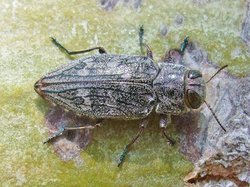April's Pest of the Month
Current Threats To Your Trees: Pests and Diseases
Chrysobothris femorata also known as the Flatheaded Apple Tree Borer
Hosts: Pecan, Hickory, Apple, Pear, Peach, Apricot, Plum, Cherry, Quince, Currant, Walnut, Poplar, Willow, Beech, Chestnut, Oak, Elm, Hackberry, Sycamore, Mountian Ash, Serviceberry, Hawthorn, Redbud, Maple, Horsechestnut, Linden, Persimmon, Boxelder. Maple, Apple, and Poplar are the preferred hosts, but many other trees are also readily attacked.
Range: A pest of many deciduous trees from Mexico throughout the United States into Canada(Brooks 1919a, USDA FA 1985)
Description:
Adult: Broad, oval, flattened beetle about 7 to 16mm long(Brooks, Moznette and others 1931). Metallic hued and indistinctly marked with dull gray spots and irregular bands. Underside coppery bronze and beneath the wings metallic greenish blue.
Egg: Pale yellow, flattened, disk-like, wrinkled, and about 1.5mm in diameter. Firmly attached to bark by their flat surfaces.
Larva: Yellowish white, legless, and about 25mm long fully grown. Three thoracic segments much broadened and compressed, giving larva apperance of having large flattened head, which accounts for its name. Within galleries, larvea nearly always assume shape of a horseshoe.
Pupa: Somewhat yellower than larva; resembles adult; 7 to 19mm long.
Biology: Adults appear from March to November but are most abundant during May(Fenton 1942, Moznette and others 1931). Beetles, most active in full sunlight, run rapidly and take flight quickly when disturbed. On hot, clear days, beetles are found on the sunny sides of trunks and larger branches. Females spend much of the time running over the surface, probing the bark with their ovipositors for oviposition sites. Females mate and begin ovipositing in 4 to 8 days and live about a month. Females lay about 100 eggs each, depositing them singly in cracks or crevices of the bark, under bark scales, and at bark injuries. Eggs hatch in 8 to 16 days. Newly hatched larvae chew through the bark and feed in the phloem and surface of the sapwood. Here, they prepare pupal chambers by plugging the burrows tightly with frass and pass the winter still as larvae within the pupal chambers. Larvae pupate for 8 to 14 days in spring or early summer. Adults emerge by cutting oval emergence holes through the bark. In most areas, one generation is produced per year, but in some areas, the requires 2 to 3 years.
Injury and Damage: Points of infestation can usually be detected by white, frothy sap oozing from cracks in the bark(brooks 1919a, Fenton 1942, Moznette and others 1931). Bark gradually becomes darkened, wet, and greasy in appearance. Little or no frass is ejected except at cracks in the bark. Attacks occur on both trunks and branches and are most common on the sunny aspect trees. Burrows under the bark are broad and irregular and packed tightly with fine, sawdust like frass. In young trees with thin bark, tunnels are usually long and winding, sometime encircling the tree. Injured areas usaully become depressed, and later the bark may split at injured sites. In older trees with thick bark, burrows are confined to a circular area within the bark. Wounds may be enlarged by succeeding generations. This borer generally attacks trees that have recently been transplanted, stressed, or whose bark has been damaged by tools, disease, rodents, sunscald, or other insects. Leaning and drought stressed trees are especially attractive to beetles. Injury results from larvae tunneling in the bark and cambium. Trees 5cm or less in diameter may be girdled and killed, and larger trees may be severely weakened and scarred. Because wooded tracts often harbor large populations, damage is usally most prevalent when plantings are close to woodlands or old declining orchards.
From: Solomon, J.D. 1995. Guide to insect bores of North American broadleaf trees and shrubs. Argic. Handbk. 706. Washington, DC: U.S. Department of Agriculture, Forest Service. 735p.
IF YOU HAVE ANY QUESTIONS AS TO THE HEALTH OF YOUR TREES, DO NOT HESITATE TO CALL THE CITY FORESTER, BRIAN JOHNSON AT 857-4178. Healthy trees are happy trees!
